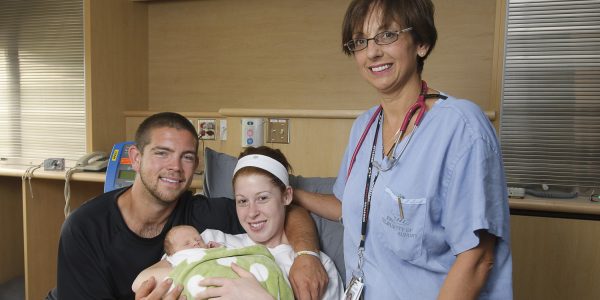Richmond Hospital is best in BC for vaginal births
The results are in and Richmond Hospital’s Birth Centre ranks at the top of provincial maternity care sites where more first-time mothers give birth vaginally than by any other means.
At 82 per cent, Richmond Hospital has the highest vaginal delivery rate for first-time mothers for facilities of similar size in BC. Comparatively, Perinatal Services BC (PSBC) data for 2015/16 shows that the vaginal delivery rate for first-time mothers has decreased from 73 per cent in 2010/11 to 70 per cent in 2014/15.
The results don’t come as a complete surprise to Diane Bissenden, director, Population and Family Health, VCH Richmond.
“All our leaders are part of a collective effort to build team, focus on quality issues, and solve problems together,” she said. “We have a strong culture that supports normal vaginal birth.”
C-section rates on the rise
British Columbia, for the past 15 years, has had one of the highest caesarean delivery rates in Canada. While there is a need for access to safe and timely caesarean delivery, achieving an optimal rate of vaginal delivery for low-risk women is a priority area of monitoring for PSBC for reasons that are numerous.
Women who deliver vaginally recover more quickly after birth than those who have caesarean deliveries, and newborns are less likely to be admitted to neonatal intensive care units than those born by caesarean.
Benefits also extend to future pregnancies. First-time mothers account for nearly 40 per cent of all deliveries in BC, so maternity care practices that promote vaginal delivery in first-time mothers may help decrease the overall caesarean delivery rate in BC.
Richmond’s steps to success
According to Bissenden, the Birth Centre’s first steps toward achieving success lies in the fact the medical and nursing team has embraced a new definition of active labour that enables the team to provide woman arriving in early labour with the education and support needed for them to return home until labour is more well established.
When women are admitted to the Birth Centre, perinatal trained nurses provide them with one-to-one labour support, which increases the staff’s capacity to support patients through the challenges of labor and giving birth.
“Nurses encourage patients to cope with labour pain with different natural interventions, such as walking, birthing balls, bathing, and pushing in different positions,” said Bissenden. “They also provide emotional support and coaching to both the mother and her partner.”
Other factors, according to Bissenden, that promote a safe birth culture for the mother include minimizing the number of people entering her room when she is labouring and minimizing a change in the nurse providing care during the critical part of labour when labour has not been easy or straightforward.
Richmond Hospital also has normal labour nurse experts who demonstrate a consistent practice of labour support during the first stage of labour, and who help the new mother-to-be delay pushing until she feels the physiologic urge to do so.
It always comes down to teamwork
The collaboration between maternity care providers and staff at Richmond Hospital is a key success factor.
“Our vision of building a strong, inter-professional collaborative team has created this culture through intentional focus on working together through relationships,” said Bissenden. “This is at the core of everything we do at the Birth Centre.”
Learn more about high quality maternity care
PSBC has been publishing Facility-Level Indicators data for the last three years.
Hospitals with planned maternity services and health authorities can use the information from the maternal and neonatal indicators to identify and monitor quality improvement and safety initiatives. Rates for each hospital are presented alongside the rate for its peer group (facilities with similar delivery volumes) and the provincial rate.


Mary Ackenhusen, CEO
great job Richmond!! To be the best on this important indicator is very impressive.
Mary